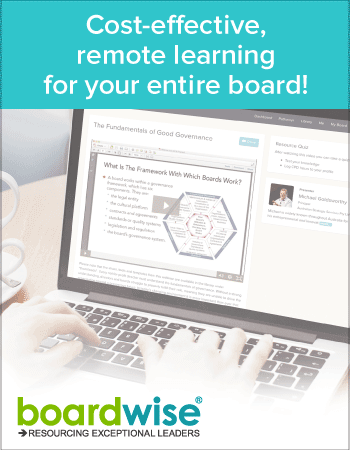glossary
Admissible
Governance GlossaryPublished: January 25, 2024

Meeting minutes serve as a legal record of what occurs in a not-for-profit board meeting and can be admissible as evidence during court proceedings. Naturally, board members are responsible for assigning a responsible person to write down motions and approved actions made by directors. Typically, the secretary is tasked with recording the meeting minutes in a timely and accurate way. This is part of the organisation’s obligation to perform due diligence and is an important risk management tool.
Board approved minutes are not only a regulatory requirement, but they can help protect an organisation from liability and serve as proof of active and informed discussions. Maintaining good records can help organisational leaders understand and identify financial, regulatory, and performance risks and involves acknowledging and acting on them. Keeping records of all matters related to not-for-profit governance is essential to managing liabilities.
Admissible vs Inadmissible
What is the difference between admissible vs inadmissible information? The National Archives of Australia makes a distinction between admissibility and weight of evidence when it comes to deciding whether records are admissible. Sometimes, a judge may not believe the evidence presented or choose not to act on facts that are admissible. Examples of situations where this might happen are things like:
- Direct observations by a witness.
- Events that occurred a long time ago.
- Confusing testimony by a witness.
- A witness has a physical incapacity such as poor eyesight.
- Motivation to lie such as having ill-will against the defendant or litigant.
Documentary evidence can become inadmissible if the judge decides it is irrelevant to the issue or if it is excluded based on rules against hearsay evidence, similar fact evidence, or opinion evidence. That is, the information is an opinion, hearsay, or similar to other facts presented. The admissibility or weight of a written record can also be negatively affected if it wasn’t created around the same time as the events it documents.
Are Meeting Minutes Admissible?
In 2001, the James Hardie Group restructured its business to protect itself from liabilities and compensate asbestos claimants. It did not have the available funds to meet the claims volume. Ten years later, the High Court of Australia heard the ASIC v Hellicar (James Hardie) case and ruled that seven Directors had breached their duties of care and diligence. The board’s meeting minutes were important evidence because they occurred in nearly the same time period as events.
Australia’s Corporations Act 2001 (Cth) requires that minutes be treated as a record of all decisions and actions made by directors during meetings because they are admissible as evidence of a court proceeding. There are three key obligations for board meetings. A minute book that documents meeting proceedings and resolutions within one month of the event must be maintained. Meeting minutes must be approved and signed by the chair within a reasonable time after the meeting. If a company or organisation has only one director, they must document declarations and keep them minute books.
Any elections, committee appointments, names of attendees, approval of previous minutes must be included in the documentation. Additionally, no changes to the minutes can be made once they’ve been approved. Good records are a critical tool for understanding major decisions and actions taken by the organisation years after the meetings have occurred.
Admissibility and NFP Legal Obligations
The Australian Charities and Not-for-Profits Commission Act 2012 states that an Australian Charities and Not-for-Profit Commission (ACNC) officer can ask that a registered charity provide documents or copies of records when monitoring and ensuring compliance. During court proceedings, if evidence is relevant to the case, it can help prove or disprove a fact. In Australia, the ‘rules of evidence’ help determine whether a fact can be proven in a court of law. These rules will affect which information is submitted before a judge, and what documents the organisation is asked to share.
Not-for-profit organisations are exposed to a variety of legal liabilities. Some of the most common risks involve social media misuse, copyright or trademark infringements, or a lack of insurance coverage. Other liabilities can occur from incidents of workplace bullying or sexual harassment, misuse of tax-exempt status, or failure to properly manage conflicts of interest. Any documented evidence that might be admissible in court is weighed against the ‘rules of admissibility’ and assessed by the judge for its quality.
What is a record of information (document)?
According to the Commonwealth Evidence Act, a record of information or ‘document’ is anything on which information is written such as marks, figures, symbols, or perforations that have meaning for a person qualified to read and understand them. It also includes sounds, images, or writings that can be reproduced with or without the help or technology, as well as maps, plans, drawings, or photographs. Metadata, paper or digital reproductions (copies), and duplicates are also considered documents.
What is the Commonwealth Evidence Act?
The Commonwealth Evidence Act regulates how documents produced by companies and incorporated non-profits are admitted in evidence in a federal court. The rules are meant to reduce restrictions on evidence that make information admissible and available for fact finding. The Act removes the ‘best evidence rule’ and allows Courts to consider more evidence from the contents of documents. It narrows the hearsay rule and can give more admissibility to hearsay evidence. The Act also expands eligibility of proof by considering business and official records and documents or electronic communication recorded or created by non-profits.
Additional Resources
Free Minute Taking Course: An Introduction for Boards
Recommended Reading
Recommended Viewing
Author
- About
-
Better Boards connects the leaders of Australasian non-profit organisations to the knowledge and networks necessary to grow and develop their leadership skills and build a strong governance framework for their organisation.
Found this article useful or informative?
Join 5,000+ not-for-profit & for-purpose directors receiving the latest insights on governance and leadership.
Receive a free e-book on improving your board decisions when you subscribe.
Unsubscribe anytime. We care about your privacy - read our Privacy Policy .










